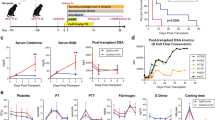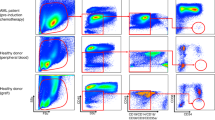Abstract
A novel in vitro assay of renal epithelium tight junction function was used to assess the efficacy with which rabbit anti-thymocyte globulin (ATG) blocks epithelium damage mediated by lymphokine-activated killer (LAK) cells. It was found that LAK cells lysed renal epithelial cells poorly in standard chromium-release assays but that they caused a rapid, and almost total, reduction in trans-epithelium monolayer resistance, indicating tight junction failure and, hence, loss of tissue function. LAK cell-mediated cytolysis of the sensitive K562 cell line was completely blocked in the presence of ATG at a concentration of 200 μg/ml. Addition of ATG at this concentration to damaged renal cell monolayers in the presence of LAK cells allowed the trans-monolayer resistance to recover rapidly to levels approaching the values recorded before initial addition of LAK cells. On this basis it seems likely that the rapid restoration of renal function frequently observed after appropriate “rescue” therapy during episodes of acute rejection may reflect subtle changes in tissue function rather than recovery from widespread graft cell cytolysis.
Similar content being viewed by others
References
Brunner KT, Mauel J, Cerrotini J-C, Chapuis B (1968) Quantitative assay of immune lymphoid cells on 51-Chromium labelled allogeneic targets in vitro; inhibition by isoantibody and by drugs. Immunology 14:181
Cereijido M, Robbins ES, Dolan WJ, Rotunno CA, Sabatini DD (1978) Polarized monolayers formed by epithelial cells on a permeable and translucent support. J Cell Biol 77:853
Givan AL, Shenton BK, White MD, Proud G, Taylor RMR (1990) Monitoring of transplant patients' lymphocytes: knowledge of the varying specificities of anti-lymphocyte antibodies allows the interpretation of anomolous results. Clin Immunol Immunopathol 54:419
Gumbiner B (1987) Structure, biochemistry, and assembly of epithelial tight junctions. Am J Physiol 253:C749
Kirby JA, Forsythe JLR, Proud G, Taylor RMR (1989) Renal allograft rejection: possible involvement of lymphokine-activated killer cells. Immunology 67:62
Kirby JA, Forsythe JLR, Simm A, Proud G, Taylor RMR (1989) Renal allograft rejection: protection of tubular epithelial cells from lymphokine activated killer cell mediated lysis by pretreatment with cytokines. Nephrol Dial Transplant 4:824
Kirby JA, Givan AL, Shenton BK, Talbot D, Forsythe JLR, Lennard TWJ, Proud G, Taylor RMR (1990) Renal allograft rejection: possible role of antibody dependent cell-mediated cytotoxicity. Transplantation 50:225–229
Kirby JA, Morgan JC, Shenton BK, Lennard TWJ, Proud G, Taylor RMR (1991) Renal allograft rejection: functional impairment of kidney epithelial cell monolayers mediated by lymphokine activated killer cells and by antibody. Transplantation 51:891
Madara JL, Hecht G (1989) Tight (occluding) junctions in cultured (and native) epithelial cells. In: Matlin KS, Valentich JC (eds) Functional epithelial cells in culture. Liss, New York, pp 131–163
Martin S, Brenchley PE, O'Donaghue DJ, Dyer PA, Mallick NP, Johnson RWG (1987) The identification of allo- and autolym-phocytotoxic antibodies in the serum, in the presence of rabbit antithymocyte globulin. Tissue Antigens 31:26
Miltenburg AMM, Meijer-Paape ME, Daha MR, Bockel JH van, Weening JJ, Es LA van, Woude FJ van der (1989) Donor-specific lysis of human proximal tubular epithelial cells by renal allograft-infiltrating lymphocytes. Transplantation 48:296
Podack ER (1985) The molecular mechanism of lymphocyte-mediated tumor cell lysis. Immunol Today 6:21
Richardson JCW, Simmons NL (1979) Demonstration of protein asymmetries in the plasma membrane of cultured renal (MDCK) epithelial cells by lactoperoxidase-mediated iodination. FEBS Lett 105:201
Strom TB, Tilney NL, Paradysz JM, Carpenter CB (1977) Cellular components of allograft rejection: identity, specificity and cytotoxic function of cell infiltrating acutely rejecting allografts. J Immunol 118:2020
Williams GM (1984) Clinical course following renal transplantation. In: Morris PJ (ed) Kidney transplantation: principles and practice. Grune and Stratton, London, p 335
Wilson PD, Horster MF (1983) Differential response of defined distal nephron epithelia in culture. Am J Physiol 244: C166
Author information
Authors and Affiliations
About this article
Cite this article
Clark, K.R., Kirby, J.A., Baker, N. et al. Renal epithelium: reversal of cytotoxic damage by addition of anti-thymocyte globulin. Transplant Int 4, 210–214 (1991). https://doi.org/10.1007/BF00649105
Received:
Revised:
Accepted:
Issue Date:
DOI: https://doi.org/10.1007/BF00649105




